Comparing 1.25 vs 1.5 Carat Diamonds: Key Insights
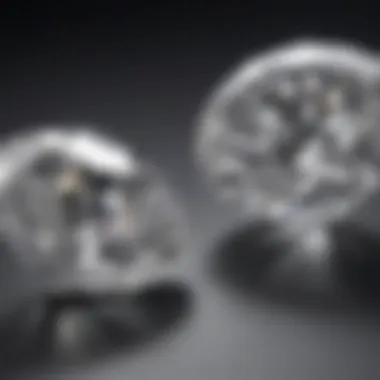
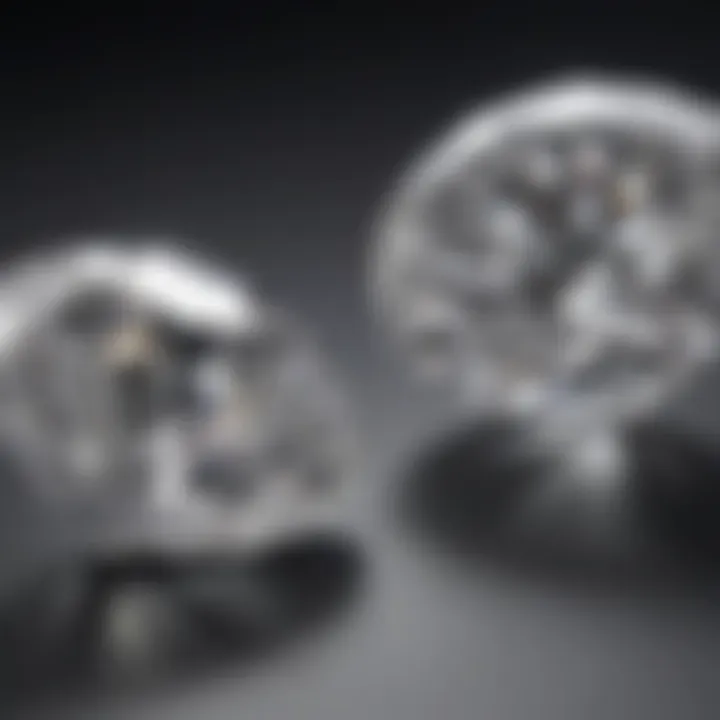
Intro
When it comes to diamonds, even a small difference in carat weight can create significant conversations amongst enthusiasts and potential buyers alike. While one might think that diamonds weighing just a quarter carat apart would hardly matter, the realities of size perception, pricing, and quality can lead to quite the debate. This analysis focuses on comparing 1.25 vs 1.5 carat diamonds, guiding readers through the intricacies that define these gems beyond their size.
Gemstone Overview
In the world of diamonds, the term "carat" refers to the unit of weight used to measure gemstones. It is essential to understand that a diamond's weight does not directly translate to its size. Cultural metrics and visual impressions often interplay to shape consumer preferences, leading to varied decisions when purchasing.
Definition and Characteristics
A carat is defined as 200 milligrams. Thus, a 1.25 carat diamond weighs 250 milligrams, while a 1.5 carat diamond weighs 300 milligrams. However, the visual difference may not be as pronounced as one might assume. For example, the diameter of a well-cut round diamond may differ only slightly.
Characteristics such as cut, color, and clarity play crucial roles in how a diamond appears to the eye. These factors can sometimes overshadow the weight aspect, suggesting that a 1.25 carat diamond with excellent cut and clarity could look more appealing than a bulky but poorly cut 1.5 carat diamond. When shopping, it’s advisable to examine these features in conjunction with carat weight.
Classification of Gemstones
Diamonds fall under the category of precious stones, often classified based on their physical and optical properties. The following are common classifications within the diamond industry:
- Natural Diamonds: Formed deep within the Earth over millions of years under high pressure and temperature conditions.
- Synthetic Diamonds: Created in labs through processes that mimic natural formations. These can often be less expensive but typically possess the same chemical characteristics.
- Fancy Color Diamonds: This variation includes diamonds of various hues, such as yellow, blue, and pink, typically priced higher due to their rarity.
Understanding these classifications provides an enhanced insight when comparing weight and size, empowering buyers with knowledge that can inform their choices.
Historical Significance
Diamonds have held a place of intrigue and allure throughout human history. Understanding this significance gives context to the value and admiration we still hold for these stones.
Ancient Uses and Cultural Importance
From the ancient Greeks who believed diamonds were tears from the gods to the mystique surrounding their use as tokens of love, diamonds have shaped human culture. In many civilizations, they were considered symbols of power and wealth, often adorned in crowns and jewelry of rulers. Their allure has attracted poets, artists, and royalty for centuries, embedding diamonds into the fabric of human love and ambition.
Myths and Legends Surrounding Gemstones
Throughout history, many legends have been tied to diamonds, enhancing their mystique. One popular tale suggests that diamonds bring luck and protect from treachery, often leading men to consider them as gifts to show commitment. In various cultures, it is believed that wearing diamonds can heal ailments and grant mystical powers. Though these stories may lean into the realm of urban legend, they contribute to the continued fascination with these exquisite stones.
"Diamonds are the perfect example of nature's creativity, tempered by time and cherished through culture. They speak of love but also of power, symbolizing desires beyond mere adornment."
Understanding Carat Weight
Carat weight plays a pivotal role when discussing diamonds, impacting not just their appearance but also their pricing and the general perception of quality. In this analysis, it’s essential to grasp how this measurement affects various facets of diamond selection. The nuances between a 1.25 and 1.5 carat diamond can be subtle at first glance, yet they hold significant implications for enthusiasts and potential buyers alike.
Understanding carat weight means moving beyond the scale. It involves significant considerations about how size correlates with value, aesthetics, and the market. Buyers are often faced with choices that come accompanied by expectations—expectations shaped largely by societal norms, personal preference, and intended use in jewelry. Therefore, comprehending carat weight is a step towards making an educated decision in the labyrinth of options available.
Defining Carat Weight
Carat (not to be confused with karat, used for gold purity) is a standard measurement for gemstone weight, with one carat equating to 200 milligrams. The term itself derives from carob seeds, which were historically used as weight measures for precious stones. This measure is vital as it directly relates to the diamond's size, albeit indirectly. For instance, a diamond that weighs 1.25 carats will appear larger than one of lower carat weight, though other factors like cut and shape can impact perceived size as well.
It's also noteworthy that bigger isn’t always better. A heavy stone set poorly loses visual impact. Thus, carat weight should be viewed within the context of the diamond's overall quality, which leads to more thoughtful purchasing decisions.
The Role of Carat in Pricing
When diving further into the conversation of pricing, carat weight is both a straightforward and complex factor. Generally, as the carat weight increases, so does the price. This is not just because they are rarer, but also due to market demand. A 1.5 carat diamond will typically carry a higher price tag compared to a 1.25 carat diamond, given that consumers often perceive larger diamonds as more desirable.
However, there exists an interesting reality within this roller coaster of pricing dynamics. Sometimes, the increase in cost is not strictly proportional. For instance, there could be a jump in price at the 1.5 carat mark, where it transitions from a middle category diamond into a more prestigious class. Thus, despite being only a quarter-carat heavier, the 1.5 carat diamond can cost considerably more due to its positioning in the market and consumer psychology.
"In the jewelry world, sometimes it's not just about weight, it's the story and the emotion behind the piece that enhances its value."
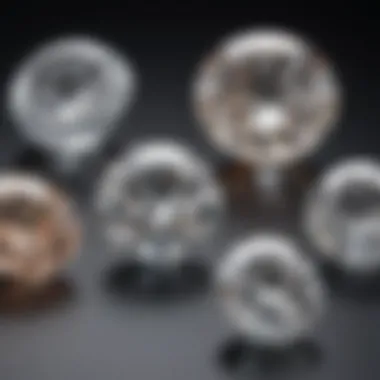
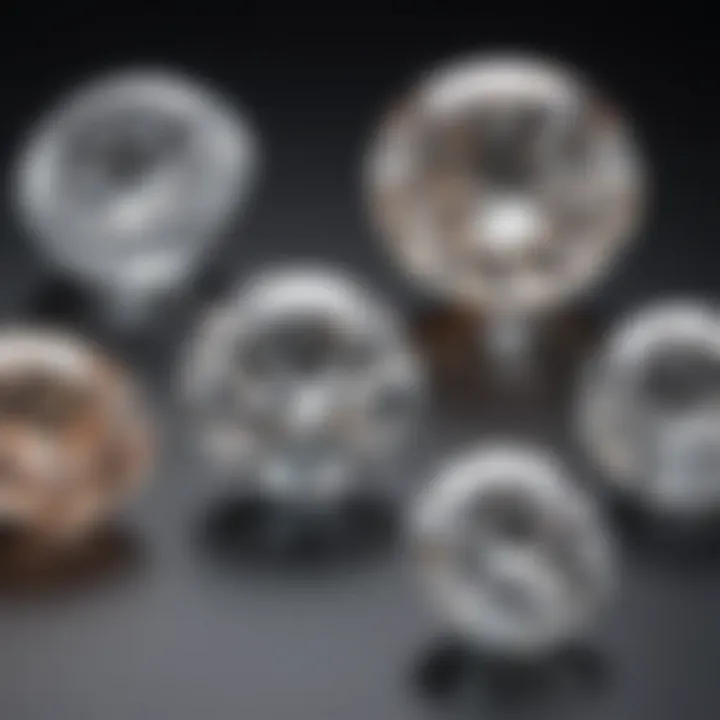
To truly understand pricing, one must consider quality as well. Factors like cut, color, and clarity can influence how much a buyer might be willing to pay, regardless of carat weight. Therefore, looking at carat in isolation could lead to a skewed perspective on value.
In summary, knowing the carat weight helps frame both the expectations and the experience of purchasing diamonds, guiding consumers through the intricate web of market trends and personal choices.
Visual Size Assessment
Understanding how visual size assessment works is fundamental when deciding between 1.25 and 1.5 carat diamonds. The perception of size goes beyond mere numbers. When choosing a diamond, buyers often base their decisions on how big a stone appears on the finger or in the light, rather than just the carat weight alone. This section explores the nuanced impacts of carat weight on appearance and the surrounding perceptions involved.
How Carat Weight Affects Appearance
The way carat weight influences a diamond's appearance is a blend of art and science. For instance, a 1.5 carat diamond appears noticeably larger than a 1.25 carat diamond, though the difference in weight might seem minimal. The average person might struggle to distinguish the two weights without side-by-side comparison, yet upon closer inspection, the effects of that extra weight can be quite striking.
The cut of a diamond plays a substantial role in this visual impact. A well-cut diamond captures and refracts light flawlessly, making it sparkle more, thereby enhancing its apparent size. On the other hand, a poorly cut diamond may not reflect light effectively, leading it to appear smaller than its carat weight would suggest. Thus, while carat size matters, the quality of the cut is essential.
Moreover, the shape of the diamond can alter its perceived size. For instance, a round brilliant cut typically appears larger for its carat weight compared to a square princess cut. In addition to cut and shape, the diamond's setting can further affect its appearance.
Comparative Size Perception
When it comes to comparative size perception, the human eye cannot help but be influenced by contexts. It's often said that diamonds are best viewed in a variety of lights and settings. This subjective nature of size perception means that one's perception might vary from person to person. It's similar to how clothes can look different on various body types.
For example, a person with slender fingers might find that the 1.5 carat stone seems significantly oversized, while someone with a larger finger might find both weights indistinguishable. Additionally, the overall style of the engagement ring plays into this perception as well. A diamond set in a complex setting may draw attention away from its size, while a simple band could accentuate its brilliance.
According to a recent discussion on Reddit, buyers often express surprise at how much larger a 1.5 carat diamond looks compared to a 1.25 carat one, stating that it often feels like "more bang for your buck."
In summary, visual size assessment combines various elements—carat weight, cut quality, shape, and personal context. By understanding these factors, potential buyers can make more informed decisions and find a diamond that suits their individual preferences, enhancing their overall experience.
Quality Considerations
When it comes to diamonds, quality is the bedrock of understanding their true value. This piece delves into the significance of quality considerations, particularly when contrasting diamonds of 1.25 and 1.5 carats. While size may catch the eye, it’s the quality that often makes the heart ache with desire. This section explores key elements like the Four Cs: Cut, Color, Clarity, and Carat Weight. It assists potential buyers in navigating choices that affect not just beauty but longevity and resale value, ensuring they find a diamond that resonates with their personal taste and investment goals.
The Four Cs: Key Factors
Cut
The cut of a diamond is perhaps the most crucial element influencing its overall appeal. It determines how light interacts with the stone, which can dramatically enhance or diminish its inherent beauty. A well-cut diamond sparkles and reflects light in spectacular ways, while a poorly cut diamond may appear dull regardless of its carat weight. A hallmark of a quality cut is symmetry; this refers to how well the facets align, ensuring light travels through the stone efficiently. Diamonds with a higher cut grade can be a wise investment as they typically command better resale prices and provide visual delight beyond the initial purchase.
Color
Color grading is another essential part of the diamond evaluation. Unlike popular belief that diamonds must be colorless to be valuable, the right shade can add character. For instance, diamonds in the G-H range often exhibit near-colorless qualities and appear more appealing to most buyers. An expertly cut colored diamond can be stunning and rare, setting it apart in a world of traditional whites. Collectors might find added value in fancy color diamonds like pink or blue, but these come with unique pricing structures that require careful consideration.
Clarity
Clarity reflects the purity of the diamond, assessing the inclusions and blemishes that could affect its overall look. Higher clarity ratings usually mean fewer visible imperfections, which enhances the beauty and desirability of the diamond. However, it's key to remember that sometimes, tiny inclusions can add character and uniqueness to the stone. One might argue that diamonds with inclusions visible only under magnification can still fascinate those who don’t scrutinize their jewels with a jeweler’s loupe. The balance between personal preference and clarity grade is an essential factor in considering quality.
Carat Weight
Carat weight is a double-edged sword. This factor is often perceived as the most straightforward since it correlates with price directly. However, while the difference between 1.25 and 1.5 carats may seem trivial in terms of weight, it could represent a significant increase in cost. Buyers should weigh their options, as a larger carat weight doesn’t automatically mean a better or more beautiful diamond. Still, a well-proportioned, smaller stone can dazzle more than a larger one with poor attributes. Understanding this nuance aids in making a more informed decision.
Impact of Size on Quality Ratings
The size of a diamond can play a surprisingly pivotal role in how its quality is perceived and rated. Larger diamonds might draw attention because of their weight, but they can also carry expectations of higher quality across the board. In the case of 1.25 versus 1.5 carats, it’s not simply about heft; it’s about how various aspects combine to create a captivating gem.
In summary, while contemplating 1.25 and 1.5 carat diamonds, the insights into cut, color, clarity, and carat weight offer a comprehensive framework for evaluating overall quality. Each element is interlinked, helping potential buyers navigate the fascinating yet complex world of diamonds.
Market Trends and Pricing
Understanding market trends and pricing is crucial when it comes to selecting the right diamond, particularly when comparing carat weights like 1.25 and 1.5 carats. This isn’t just about numbers; it's about how those numbers translate into value and desirability in today’s marketplace.
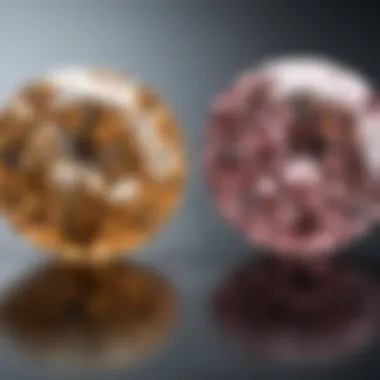
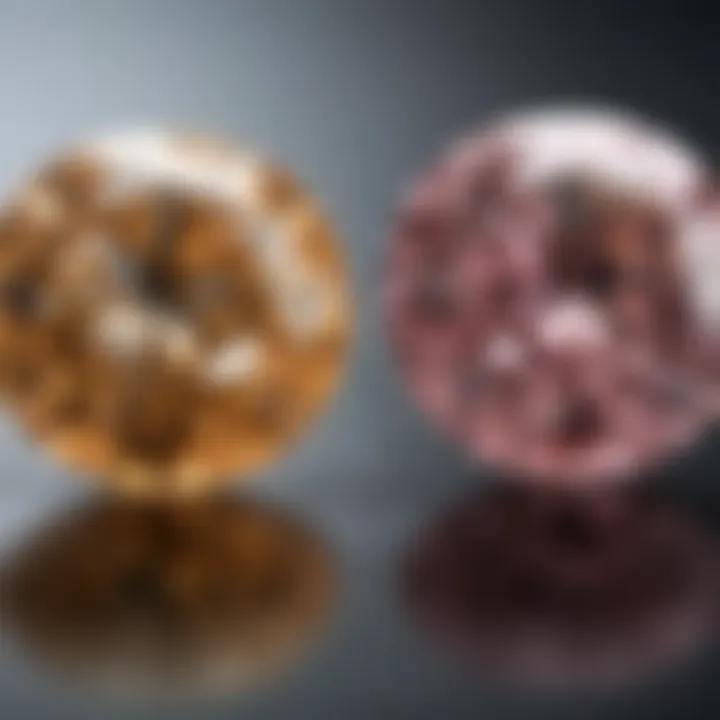
When consumers think about purchasing a diamond, they often consider not only the physical attributes of the gem, but also how that gem fits into cultural and economic narratives. The value of a diamond is influenced by current market trends, which can fluctuate based on demand, rarity, and even shifts in consumer preferences.
Investing time to comprehend these elements provides you with a stronger footing in negotiations, ensures you make an educated choice, and aids in grasping the broader context of diamond ownership. Quite notably, being mindful of market dynamics can potentially save you a significant sum, or yield greater returns on resale.
Price Range Analysis
In the world of diamonds, price tags can be as varied as the stones themselves. For 1.25 and 1.5 carat diamonds, the price difference often reflects not just the increased weight but various market factors at play. On average, a 1.25 carat diamond might set you back between $6,000 to $9,000, while a 1.5 carat diamond generally ranges from $8,000 to $12,000.
What's striking here is that, despite only a .25 carat difference, the price can shoot up significantly because of perceived value and market demand. Generally, diamonds that sit slightly above popular benchmarks, like the transition from 1.0 to 1.5 carats, garner higher prices due to their rarity. Buyers might overlook the smaller sizes; however, the appeal of a larger carat can pull on heartstrings.
- Factors Influencing Price:
- Demand in the luxury market
- Availability of larger stones
- Economic trends affecting consumer spending
Interestingly, the price isn't set in stone (no pun intended). Special sales or discounts could lead the prices of 1.25 carat diamonds to drop, making them a compelling buy. A buyer appears savvy if they know when to purchase!
Market Demand for Different Sizes
When it comes to choosing between 1.25 and 1.5 carat diamonds, understanding market demand provides additional clarity. Diamonds are not just luxurious items; they are also investment pieces, and as such, their demand varies. Typically, the 1.5 carat diamonds attract a more significant buyer interest, largely because they are often seen as a sweet spot between size, price, and quality.
Much of the current market sentiment favors larger carat weights for engagement rings and jewelry—something that social media platforms like Facebook can amplify. The dazzling images of large diamonds displayed can fuel consumer desire for more substantial gems. However, the market for 1.25 carat diamonds shouldn't be glossed over. These jewels can often demonstrate an excellent blend of beauty and affordability, making them quite sought after among more budget-conscious buyers.
"A larger diamond may grab the spotlight, but the allure of a well-crafted piece at a reasonable price can outshine it in the right light."
In summary, while larger carats rank highly in desirability, the continuous demand for 1.25 carat diamonds persists, fueled by both practicality and an eye for elegance. Understanding these demand cycles and pricing structures empowers buyers to navigate their diamond quest with confidence.
Investment Perspective
When deciding between a 1.25 and a 1.5 carat diamond, the investment angle becomes crucial. These stones are not just glorious pieces of jewelry; they can also be wise investments. Recognizing how carat can affect both the initial purchase price and resale potential is important. Let’s explore the elements that greatly influence the investment viability of these two carat sizes.
Resale Value Considerations
Resale value is one of the topics that potential diamond buyers often overlook. For many, the thought of selling a diamond might seem distant, but understanding the future market can be the difference between a sound or a poor investment.
When you consider a 1.5 carat diamond compared to a 1.25 carat one, the size might appeal to buyers more, but there are nuances. Bigger does not always mean better in terms of value. 1.25 carat diamonds, while smaller, are appealing for their price point. They tend to have a more stable resale value because they are less dependent on market fluctuations. Buyers often find they can sell them quickly without significant loss.
On the other hand, a 1.5 carat diamond commands more attention, but its resale value might also fluctuate more due to market trends. Particularly during economic downturns, larger stones can see a decline in demand. So, keeping an eye on market demands for larger pieces is recommended.
Important Note: Keep documents like grading reports and original receipts; these can significantly influence resale value.
Investment Trends in Carat Sizes
Understanding the broader trends in the investment market can help potential buyers navigate their purchase decisions. As certain carat ranges gain or lose popularity, the value associated shifts as well. In recent years, there has been a noticeable trend towards preference for diamonds in the 1.25 to 1.5 carat range. Many buyers feel that these sizes offer a sweet spot—a balance between aesthetics and investment, allowing buyers to make an emotionally fulfilling yet financially sound choice.
- Growing Demand: More people are recognizing the significance of diamonds not just as jewelry but as investments. The market for middle-range carat sizes has shown growth, with 1.25 and 1.5 carat diamonds being among the frontrunners.
- Resilience During Market Volatility: Historical data indicates that diamonds in this size range tend to hold value better than both smaller and significantly larger diamonds.
- Preference for Quality Over Size: Buyers are increasingly leaning towards quality characteristics such as cut and clarity, rather than simply focusing on carat weight.
Personal Preferences
When it comes to choosing a diamond, the nuances of personal preference play a pivotal role. Not just about appearance or price, personal choice often intertwines with lifestyle factors, emotional significance, and cultural influences. Understanding these preferences can guide individuals towards a diamond that resonates with their unique identity.
The selection of a diamond isn’t a mere transaction; it’s a deeply personal journey. Factors such as how the diamond will be worn, whether it’s for everyday use or special occasions, influence what kind of carat weight might suit someone best. Additionally, lifestyle considerations include daily routines and activities. Someone who leads an active life might lean toward a 1.25 carat diamond for its balance of size and practicality, whereas, for someone who prefers a statement piece, 1.5 carat can be striking and memorable.
Personal connection to the gemstone often outweighs technical specifications.
Choosing Based on Lifestyle
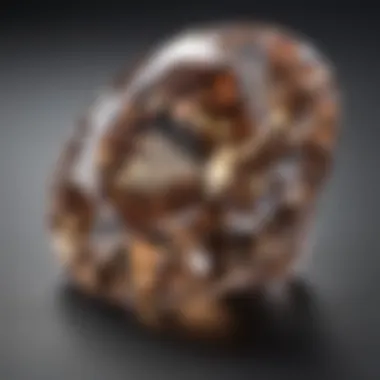
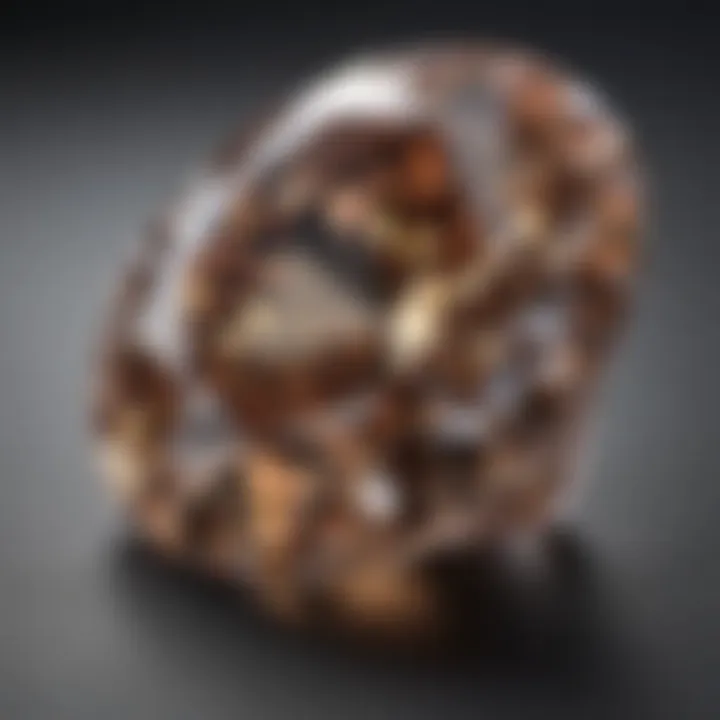
Selecting a diamond isn't just picking out a shiny rock; it's about harmonizing it with one’s way of life. The intended use — be it an engagement ring, a fashion statement, or an heirloom piece — can dictate whether a 1.25 or a 1.5 carat diamond is more suitable. For example, a 1.25 carat might offer a good size for someone who appreciates subtlety while being practical for daily wear, whereas a larger 1.5 carat can signify a more extravagant lifestyle, suited for formal events.
In terms of practicality, consider daily activities. Someone working in a hands-on environment may prefer a smaller stone to minimize the risk of losing it or damaging it. Conversely, those who have occasions to flaunt their jewelry—think galas or milestone celebrations—might opt for a larger diamond that draws attention. It hinges on understanding one’s needs and making a choice that genuinely augments the individual’s lifestyle.
Symbolic Significance of Size
In many cultures, diamonds symbolize love, commitment, and life's milestones. The size of a diamond can carry different meanings, touching upon values like abundance, status, and personal achievement. A 1.25 carat diamond often signifies a balance between modesty and elegance, appealing to those who appreciate beauty without the spotlight. On the flip side, a 1.5 carat diamond might represent a bolder statement, showcasing not just an engagement but also a commitment to a flamboyant and passionate approach to life.
Furthermore, the meaning attached to diamond size can vary from person to person. For some, a larger stone signifies stability and success, while for others, a smaller size could reflect more intimate, personal values associated with love and connection. It's vital for buyers to reflect on their own beliefs and what a diamond may represent for them in terms of emotional or cultural significance.
Setting and Style Considerations
When it comes to selecting a diamond, especially for special occasions like engagements or anniversaries, the setting and style are as crucial as the diamond's carat weight. The difference between 1.25 and 1.5 carat diamonds can greatly influence the choice of setting, which in turn affects the overall aesthetic appeal of the piece.
An appropriate setting not only enhances the diamond's beauty but also reflects personal style. A heavier diamond, like a 1.5 carat, may command a more pronounced setting, while a 1.25 carat might blend seamlessly into more delicate designs. This decision revolves around the character of the wearer, their lifestyle, and how they want to portray their gemstone investment.
Best Settings for Various Carat Sizes
1.25 Carat Diamonds
For a diamond weighing 1.25 carats, settings that showcase simplicity yet elegance often work best.
- Solitaire Settings: Focusing the viewer's attention on the diamond, a classic solitaire setting highlights its brilliance. This setting is timeless and works well for various styles.
- Halo Settings: Adding a splash of sparkle, a halo setting encircles the diamond with smaller stones. This enhances the perceived size of the diamond, giving the illusion that it’s larger than its actual carat weight.
- Three-Stone Settings: This arrangement symbolizes the past, present, and future. A 1.25 carat diamond flanked by smaller stones fits nicely, allowing for a balanced and visually harmonious appearance.
1.5 Carat Diamonds
On the other hand, for a 1.5 carat diamond, stronger settings can complement its prominence.
- Cathedral Settings: Elegant and sophisticated, cathedral settings elevate the diamond, allowing maximum light to enter, enhancing brilliance and fire. This works splendidly for a stone of this size.
- Pavé Settings: Tiny diamonds embedded into the band create a shimmering effect. This is ideal for a 1.5 carat diamond, as it exudes luxury and draws the eye.
- Custom Settings: Given its size, a 1.5 carat diamond offers room for creativity. Jewelers can personalize designs to reflect personal tastes, adding unique characteristics like engraved bands or artistic shapes.
The choice of setting ultimately shapes how the carat weight is perceived.
Complementing styles with Carat Weight
The style of jewelry must not only match the carat weight but also resonate with the individual's style and preferences. A 1.25 carat diamond may opt for a more classic approach, complementing vintage or traditional jewelry styles, while a 1.5 carat diamond aligns with more modern and bold designs.
- Traditional Styles: A 1.25 carat diamond often finds its place in vintage or timeless settings, where subtlety is paramount.
- Modern Aesthetics: For a 1.5 carat diamond, contemporary styles with geometric shapes or mixed metals may strengthen the impact of the piece.
Incorporating personal style is key. It ensures that the chosen design remains significant and valued over time, reflecting both the diamond's carat weight and the wearer’s personality.
"The right setting doesn't just showcase the diamond; it tells a story about the wearer as much as the gem itself."
As one navigates the world of diamond jewelry, understanding carat weight in conjunction with setting and style is vital for making a choice that marries beauty with personal significance.
Epilogue and Recommendations
In the intricate world of diamonds, the decision between a 1.25 and a 1.5 carat stone isn’t just about size; it encapsulates a range of elements from personal aesthetic preferences to investment strategies. This section distills the core insights gleaned from the detailed exploration throughout the article.
Understanding these differences is vital for anyone venturing into the diamond market, whether for personal adornment, a gift, or even as an investment. The nuances in carat weight directly correlate to pricing, perception, and overall quality. Thus, engaging with this knowledge not only enhances purchasing confidence but also allows for an appreciation of the diamond’s journey from the mine to the market.
Factors such as market demand, the perceived value of larger stones, and personal priorities—like lifestyle suitability versus investment potential—underscore the complexity of choosing the right diamond.
Summary of Findings
Based on the comprehensive analysis:
- Size Perception: Consumers often perceive a 1.5 carat diamond as significantly larger than a 1.25 carat stone, despite the actual difference in weight being marginal. This can influence choice based on aesthetic appeal.
- Pricing Differences: The price gap between these two carat weights can be substantial, driven by market trends and consumer behavior. Often, the 1.5 carat diamonds command a noticeably higher price per carat.
- Quality Ratings: Both sizes can exhibit varying qualities. It’s essential to go beyond carat weight and consider the Four Cs—cut, color, clarity, and carat—to assess what fits best for your needs.
- Investment Outlook: While both offer investment potential, larger carats like 1.5 may have better resale value, especially in a fluctuating market. But personal sentiment connected to the piece can outweigh this consideration.
In summary, both carat sizes deliver unique advantages and challenges and the choice between them hinges on individual priorities and values.
Making an Informed Choice
When it comes to selecting between a 1.25 and 1.5 carat diamond, conducting thorough research is key. Here are some substantial considerations:
- Evaluate Personal Preferences: Reflect on factors important to you, such as the stone's appearance on your finger, your lifestyle, and whether it fits into your everyday wear.
- Budget Flexibility: Do you have wiggle room to accommodate the price increase for a larger diamond, or does the budget necessitate a smaller, yet equally stunning, carat?
- Long-Term Value: Think about whether you view this diamond as a lifetime investment or a fleeting luxury. Sometimes, the emotional connection to the gem is worth more than its price tag.
- Consult Experts: Engaging with knowledgeable professionals can provide you with insight and might help shed light on options you hadn’t considered.
Ultimately, choosing between a 1.25 and 1.5 carat diamond is a deeply subjective journey. It requires weighing not just the financial implications but also the symbolic meaning these stones carry. This guide aims to arm you with the understanding necessary to navigate the diamond market with clarity and confidence.







